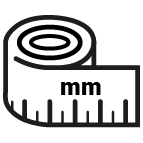
Steel Zinc Plated four pronged tee nuts
MATERIAL
Steel Zinc Plated
Starting at $0.46 $0.46
Please Login to see select CAD
Four prong tee nuts, also commonly known as pronged nuts for wood, are a sturdy low cost solution to allow a female thread to be inserted into wood or soft plastic. The tee nut has a flange at one end with 4 pointed prongs protruding which hold it flush and captive in the material, locking it and preventing rotation during assembly.
Applications for 4 pronged tee nuts are predominantly for wood framed items such as trolleys, cabinets, woodworking beds and similar.
T-nuts, or tee nuts, are a type of fastener used to create internal threads in wood, particleboard, or other soft materials, making it easier to attach objects to these materials. They are often used in furniture, cabinetry, rock climbing walls, and various other applications.
Structure
- Flange: T-nuts have a flat flange at one end, which is larger in diameter than the barrel that contains the threads. The flange has prongs or teeth that dig into the material, preventing the T-nut from turning.
- Barrel: The barrel is cylindrical and contains internal threads that can accommodate a bolt or threaded rod.
- Threads: The internal threads are designed to match the threads of the bolt or rod that will be inserted into the T-nut.
T Nut Installation
1. Drill a Hole: Drill a hole into the material where you want to install the T-nut. The hole should be slightly larger than the barrel of the T-nut but smaller than the flange.
2. Insert the T-Nut: Push the T-nut into the hole, flange side first. The prongs on the flange will help hold the T-nut in place.
3. Hammer in Place: Gently hammer the T-nut until the flange is flush with the surface of the material. The prongs will dig into the material, anchoring the T-nut.
4. Insert Bolt: Now, you can insert a bolt or threaded rod into the T-nut. Turning the bolt will cause it to thread into the T-nut, but the T-nut itself should stay in place, thanks to the prongs.
5. Tightening: As you tighten the bolt, the T-nut will be pulled tighter into the material, creating a strong, secure connection.
Applications
- Furniture: T-nuts are often used in furniture making, where they help to securely attach legs, arms, and other parts.
- Rock Climbing Walls: They are also popular in the construction of rock climbing walls, where holds need to be securely fastened to the plywood or another surface.
- Industrial Applications: In various applications where a strong connection is needed between a soft material (like wood) and a bolt or screw.
Considerations
- Material Compatibility: Ensure that the T-nut is compatible with the material you're installing it into. Some materials may not hold T-nuts as securely as others.
- Size: Choose a T-nut and bolt size that is appropriate for the load it will bear.
- Installation: Ensure that the T-nut is properly installed to avoid it pulling out under load.
Safety
- Load Bearing: Always consider the weight and stress that will be placed on the T-nut and ensure it is rated for the intended use.
- Installation: Make sure the T-nuts are properly installed to avoid any accidents or the weakening of the material they are installed in.
T-nuts provide a means to attach components securely to soft materials, offering a threaded anchor point for bolts and screws.
| MATERIAL | Steel |
|---|---|
| Unit Type | Metric |
| Stock Guaranteed | No |


